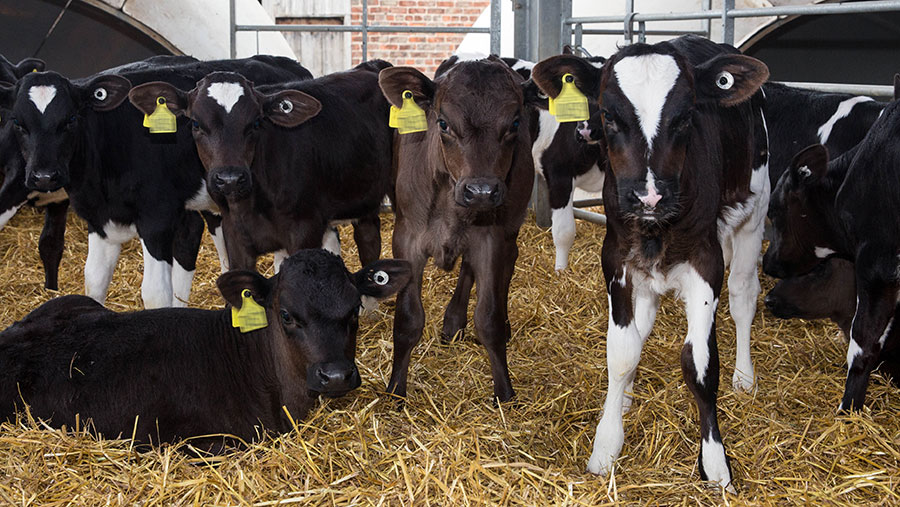10 things you may not know about coccidiosis
 © Tim Scrivener
© Tim Scrivener Coccidiosis (Eimeria) is one of the most widespread and costly livestock diseases, causing significant gut damage and production losses in lambs and calves.
Coccidiosis is primarily seen in young non-immune animals. In lambs, it may be seen when animals are only two weeks old, but typically it causes disease in lambs aged four to six weeks.
While it is most commonly diagnosed in calves between three to 12 weeks of age, it is often seen within a few weeks of mixing groups.
See also: Q&A: How to prevent and treat coccidiosis in calves
The timing of infection will be affected by multiple factors, including management practices, hygiene measures, coccidia species present, and will vary between individual farms.
Coccidiosis-causing oocysts can build up during the housed period, increasing the risk of disease, especially as spring turnout nears.
Dr Tim Potter, from Westpoint Farm Vets, part of the VetPartners group, says: “As stocking densities increase pre-turnout, it’s harder to keep sheds clean and dry, so you generally see a spike in oocyst numbers in the environment and therefore a heightened risk of ingestion by calves.”
The right treatment is essential to prevent production losses, but there is also a risk of the disease reoccurring.
Kayt Johnson, Bayer veterinary business manager, and Dr Potter give their insight into some of the key aspects of the disease that maybe forgotten or overlooked.
1. Coccidiosis is host-specific
The pathogenic (disease-causing) species that affect calves (such as Eimeria zuernii, Eimeria bovis and Eimeria alabamensis) will not affect lambs (which are affected by Eimeria ovinoidalis and Eimeria crandallis) and vice versa.
Lambs can therefore be turned out in a field that may have held infected calves, with no risk of cross-infection of coccidiosis.
2. The oocysts (eggs) excreted into the environment are very resilient
Coccidiosis is spread by faeces through oral transmission, so contaminated water troughs, dirty udders or sucking on dirty fences are all possible routes of infection.
Eggs can survive for more than a year and also withstand freezing temperatures. This is why it is important to thoroughly clean and disinfect housing between batches.
Coccidiosis-causing oocysts are sensitive to sunlight, so the dark corners in sheds can be a hotspot for oocysts, unless they’re decontaminated with an appropriate disinfectant.
If a field was contaminated the previous season, it is likely the following year’s animals will become infected upon turnout.
Therefore, it is advisable to follow a pasture-rotation plan, avoiding set-stocking.
3. Many disinfectants are not effective
If you are disinfecting against coccidiosis, check that you’re using a product that’s labelled coccidiocidal or oocidal and follow the correct dilution rates and contact times, after thorough cleaning.
4. Not all species of coccidiosis cause disease
An oocyst count will not identify species and will include oocysts of non-pathogenic species.
An additional test called speciation is available that can identify if pathogenic species are present and it can help with diagnosis and treatment decisions. Speak to your vet about sending samples for testing.
5. Immunity is species-specific
There is no cross-protection between the different species of Eimeria. For example, if calves or lambs are exposed to one species when housed, and then to a different species on turnout, they will not have immunity against the new species.
6. Tests can help identify subclinical infections of pathogenic species
Subclinical infections without the presence of diarrhoea may still cause gut damage and adversely affect growth rates through poor food conversion efficiency, unless treated. Oocyst counts and speciation can also help identify these.
7. Coccidiosis increases susceptibility to secondary infections
Coccidiosis damages the villi lining the gut and increases the animal’s susceptibility to secondary infections. Even after clinical signs, such as scouring, have cleared up, the gut may take weeks or even months to recover and function normally.
8. Identifying infection early is key
Once clinical signs are visible, the intestinal lining will already be seriously damaged. Therefore, identifying when infection is occurring to enable preventative treatment during the pre-patent period (before clinical signs are apparent) can limit damage to the gut and losses.
Look out for calves that appear depressed, are eating less than usual, not growing at the expected rate or have scour with fresh blood in it.
Red blood in diarrhoea shows there is damage to the lower digestive tract, and coccidiosis is a likely cause. You may also see calves with their tails up demonstrating unproductive straining, with perhaps some mucus being passed, which is due to irritation of the gut lining.
9. Stress can increase susceptibility to cocci
Try to avoid multiple stressors at the same time. These can include weaning, change of diet, disbudding, regrouping, change of housing, transportation, overstocking and temperature variations.
10. Treat all animals, not just sick ones
Coccidia multiply extensively during the lifecycle, and one ingested oocyst can result in millions of oocysts being produced and shed back into the environment.
It takes between 15 and 21 days from ingestion of the oocyst to shedding of more oocysts in the faeces, so if one animal is showing symptoms, it’s likely that more have already been infected.
Therefore, all animals within the group should be treated, and not just those showing symptoms.
How to tell the difference between subclinical and clinical symptoms of coccidiosis |
|
|
Subclinical |
Clinical |
|
Decreased appetite |
Watery diarrhoea, sometimes accompanied by straining, mucus and blood |
|
Poor weight gain |
Rapid weight loss |
|
Dull and poor coat/fleece |
Anorexia |
|
General poor condition |
Dehydration |
|
Loose faeces |
Abdominal pain and painful vocalisation |
